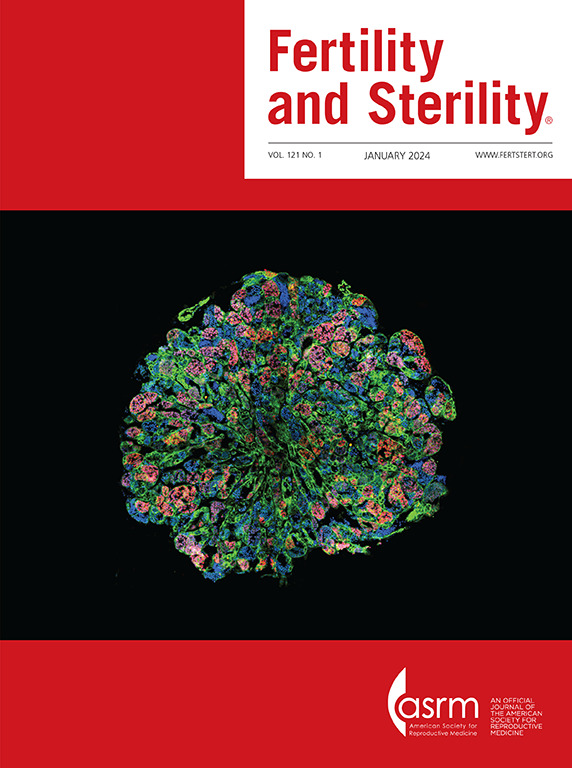A relook at the relevance of thyroid stimulating hormone and thyroid autoimmunity for pregnancy outcomes: Analyses of randomized control trials data from Pregnancy in Polycystic Ovary Syndrome and Assessment of Multiple Intrauterine Gestations from Ovarian Stimulation
IF 7
1区 医学
Q1 OBSTETRICS & GYNECOLOGY
引用次数: 0
Abstract
Objective
We examined if thyroid autoimmunity is relevant to the relationship between maternal thyroid stimulating hormone (TSH) levels and pregnancy outcomes.
Design
Retrospective cohort analysis of data from 2 randomized controlled trials (RCTs).
Subjects
Participants of the Pregnancy in Polycystic Ovary Syndrome (PPCOS II, n = 746) and the Assessment of Multiple Intrauterine Gestations from Ovarian Stimulation (AMIGOS, n = 832 with unexplained infertility) RCTs.
Exposure
Pre-RCT intervention levels of TSH at threshold of ≥2.0 mU/L and thyroid peroxidase antibody (TPO-Ab) at titer threshold of ≥30 U/mL.
Main Outcome Measures
Live birth (primary outcome), pregnancy loss, and preterm birth (secondary outcomes). Generalized linear model (GLM) analyses examined the relationship between exposure to TSH and TPO-Ab at specified thresholds with the specified outcomes; covariates adjusted for included age, body mass index, race, ethnicity, education, smoking, duration of infertility, PCOS (vs. unexplained infertility), and randomized intervention arm in the respective RCTs.
Results
On adjusted analyses, live birth was significantly reduced in the exposed population (those with TSH ≥2.0 mU/L and TPO-Ab ≥30 U/mL, n = 117/1,578, 7.4%, adjusted risk ratio [ARR]: 0.55; 95% CI: 0.35–0.87) compared with the unexposed (those with TSH <2.0 mU/L and TPO-Ab <30 U/mL, n = 865/1,578, 54.8%). Furthermore, the risk of pregnancy loss and of early preterm birth (<32 weeks) was significantly higher in the exposed compared with the unexposed (ARR for pregnancy loss was 1.66; 95% CI: 1.14–2.42, and ARR for early preterm birth was 4.82, 95% CI: 1.53–15.19).
Conclusion
In women with TPO-Ab titers ≥30 U/mL, pregnancy outcomes may be compromised at TSH threshold of ≥2 mU/L. These findings of an interaction between TSH and TPO for pregnancy outcomes merit further investigation in prospective studies.
Trial Registration Number
NCT00719186 and NCT01044862.
Una nueva mirada a la relevancia de la hormona estimulante del tiroides (TSH) y la autoinmunidad tiroidea en el embarazo: Análisis de los datos aleatorizados de control del embarazo en Síndrome de Ovarios Poliquístico y Evaluación de gestaciones intrauterinas múltiples por estimulación ovárica
Objetivo
Evaluar si la autoinmunidad tiroidea es relevante para la relación entre los niveles maternos de la hormona estimulante del tiroides (TSH) y los resultados del embarazo.
Diseño
Análisis de cohortes retrospectivo de los datos de 2 ensayos controlados aleatorizados (ECA).
Sujetos
Participantes en los ECA “Embarazo en el síndrome de ovario poliquístico (PPCOS II, n =746) y Evaluación de gestaciones intrauterinas múltiples a partir de la estimulación ovárica (AMIGOS, n = 832 con infertilidad inexplicada).
Exposición
Niveles de TSH previos a la intervención del ECA en el umbral ≥2,0 mU/L y títulos de anticuerpos de peroxidasa tiroidea (TPO-Ab) ≥ 30 U/Ml
Principales Medidas de Desenlace
Nacidos vivos (resultado primario), abortos y parto prematuro (resultados secundarios). Los análisis del modelo lineal generalizado (GLM) examinaron la relación entre la exposición a TSH y TPO-Ab en los umbrales específicos con los resultados especificados; las covariables ajustadas incluían la edad, el índice de masa corporal, la raza, el origen étnico, la educación, el tabaquismo, la duración de la infertilidad, el SOP (frente a la infertilidad inexplicada) y el brazo de intervención aleatorizado en los RCT respectivos.
Resultados
En los análisis ajustados, los nacidos vivos se redujeron significativamente en la población expuesta (aquellos con TSH ≥2,0 mU/L y TPO-Ab ≥30 U/mL, n= 117/1.578, 7,4%, cociente de riesgos ajustado [ARR]: 0,55; IC 95%: 0,35-0,87) en comparación con los no expuestos (aquellos con TSH <2,0 mU/L y TPO-Ab <30 U/mL, n= 865/1.578, 54,8%). Además, el riesgo de pérdida del embarazo y de parto prematuro temprano (<32 semanas) fue significativamente mayor en las expuestas en comparación con las no expuestas (la RRA de pérdida de embarazo fue de 1,66; IC 95%: 1,14-2,42, y la RRA de parto prematuro precoz fue de 4,82; IC 95%: 1,53-15,19).
Conclusión
En las mujeres con títulos de TPO-Ab ≥30 U/mL, los resultados del embarazo pueden verse comprometidos con un umbral de TSH de ≥2mU/L. Estos hallazgos de una interacción entre TSH y TPO para los resultados del embarazo merecen una mayor investigación en estudios prospectivos.
重新审视TSH和甲状腺自身免疫与妊娠结局的相关性:PPCOS II和AMIGOS的RCT数据分析
目的:探讨甲状腺自身免疫是否与母体TSH水平和妊娠结局之间的关系有关。设计:回顾性队列分析来自两项随机对照试验(rct)的数据。受试者:参与多囊卵巢综合征妊娠(PPCOS II, n = 746)和卵巢刺激诱导多胎宫内妊娠评估(AMIGOS, n = 832伴不明原因不孕症)的随机对照试验。暴露:试验前干预时促甲状腺激素(TSH)阈值≥2.0 mU/L,甲状腺过氧化物酶抗体(TPO-Ab)滴度阈值≥30 U/mL。主要结局:活产(主要结局),流产和早产(次要结局)。广义线性模型(GLM)分析了特定阈值下TSH和TPO-Ab暴露与特定结果之间的关系;在相应的随机对照试验中,调整的协变量包括年龄、体重指数、种族、民族、教育程度、吸烟、不孕症持续时间、多囊卵巢综合征(与不明原因不孕症相比)和随机干预组。结果:经校正分析,TSH≥2.0 mU/L和TPO-Ab≥30 U/mL的暴露人群(n= 117/1578, 7.4%,校正风险比[ARR] 0.55, 95% CI 0.35- 0.87)与未暴露人群(TSH患者)相比,活产显著减少。结论:TPO-Ab滴度≥30 U/mL的妇女,TSH阈值≥2 mU/L时妊娠结局可能受到损害。TSH和TPO对妊娠结局的相互作用值得在前瞻性研究中进一步研究。
本文章由计算机程序翻译,如有差异,请以英文原文为准。
求助全文
约1分钟内获得全文
求助全文
来源期刊

Fertility and sterility
医学-妇产科学
CiteScore
11.30
自引率
6.00%
发文量
1446
审稿时长
31 days
期刊介绍:
Fertility and Sterility® is an international journal for obstetricians, gynecologists, reproductive endocrinologists, urologists, basic scientists and others who treat and investigate problems of infertility and human reproductive disorders. The journal publishes juried original scientific articles in clinical and laboratory research relevant to reproductive endocrinology, urology, andrology, physiology, immunology, genetics, contraception, and menopause. Fertility and Sterility® encourages and supports meaningful basic and clinical research, and facilitates and promotes excellence in professional education, in the field of reproductive medicine.
 求助内容:
求助内容: 应助结果提醒方式:
应助结果提醒方式:


